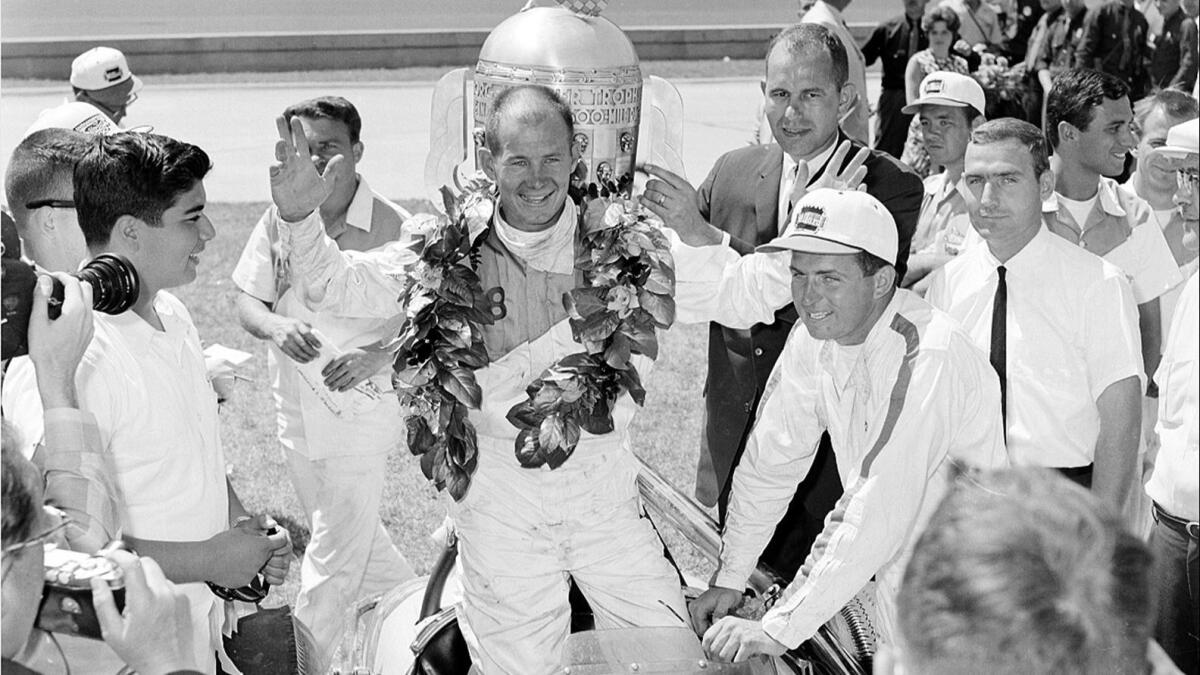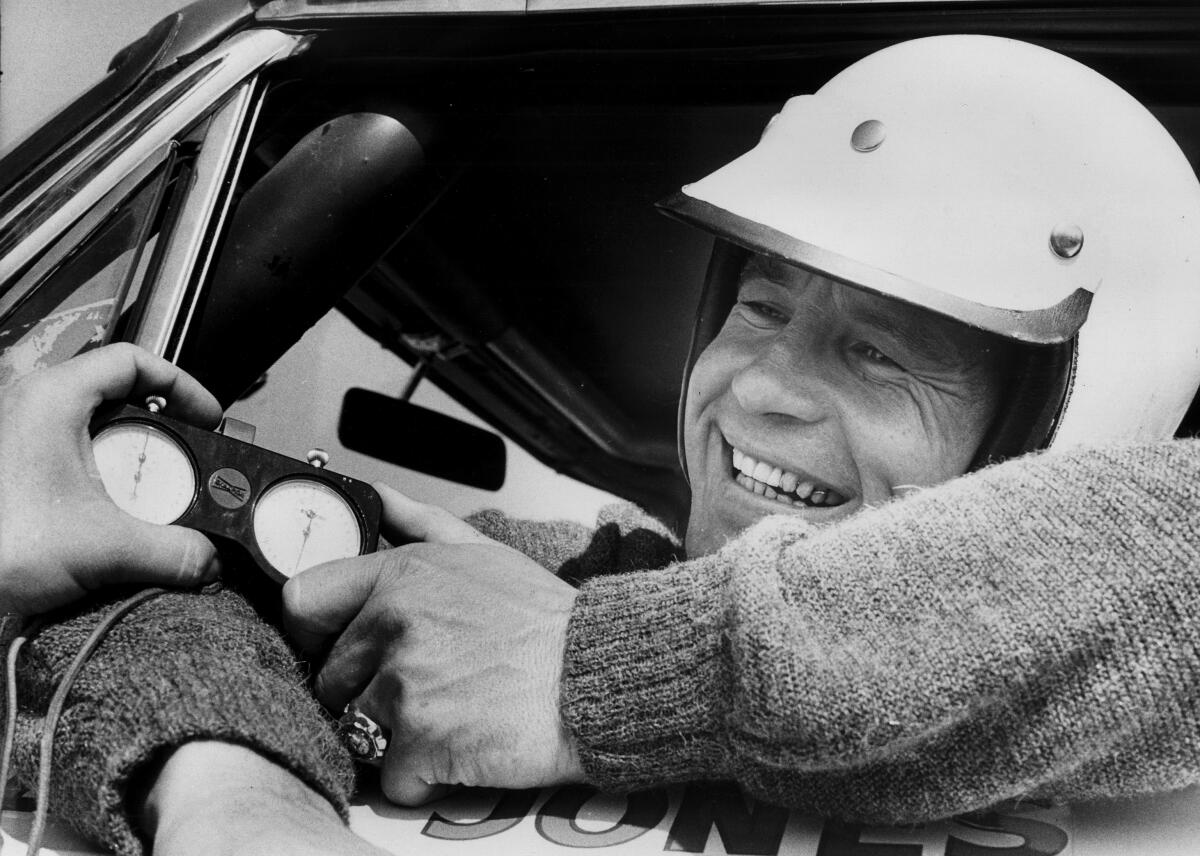Parnelli Jones, winner of controversial 1963 Indianapolis 500, dies at 90

- Share via
Parnelli Jones, a hard-bitten, hard-charging race driver who came out of Torrance and won the controversial Indianapolis 500 in 1963, then was the hard-luck loser four years later, died Tuesday at Torrance Memorial Medical Center after a battle with Parkinson’s disease. He was 90.
At the time of his death, Jones was the oldest living winner of the Indy 500. And although he won the race at Indy — then unquestionably the biggest motor sports event in the world — only once and ran in it only seven times, he stands as one of the dominant figures of his driving era, an era that also produced A.J. Foyt, Jim Clark, Dan Gurney and Richard Petty. Indeed, Jones raced against — and beat — all of them at some point in his career.
And a busy career it was, for Jones liked to drive anything that could be raced. He won in midget cars and sprint cars, Indy cars and stock cars, sports cars and, after deciding that the demands of track racing were getting in the way of his burgeoning business interests, off-road racers.
It was at Indianapolis, though, that Jones made his name and grew his fame.
Jones got there in 1961, driving for the late San Pedro promoter, character and businessman J.C. Agajanian. He qualified fifth, finished 12th and was named co-rookie of the year with Bobby Marshman. In a portent of things to come, Australian Jack Brabham finished ninth in a Cooper Climax, a modified version of the car he drove in European Formula One races. The Cooper’s engine was mounted behind the driver.
Parnelli Jones returns to Indianapolis 500 to commemorate 1963 win
In 1962, Jones electrified the Indy crowds, becoming the first driver to break 150 mph and winning the pole with a qualifying speed of 150.137. He was running away with the race when his car’s brakes failed at about 300 miles, but he kept going, eventually finishing seventh.
By 1963, things had changed at Indy. Gurney, at the time a Formula One regular from Costa Mesa, had convinced English car builder Colin Chapman that a rear-engine car could win the 500 if only it had a stronger power plant than the one that had been in Brabham’s Cooper. Chapman persuaded Ford Motor Co. to fulfill his V-8 engine requirements and built the first of what were to become revolutionary Lotus-Fords, pencil-thin cars that looked like spiders capering through the turns. There was one for Gurney and another for Clark.
Against these stood the traditional Indy roadsters, long-snouted brutes in which drivers sat bolt-upright behind the engines, most of them the growling four-cylinder Offenhausers that had ruled the speedway since the end of World War II. They made the rear-engine cars look almost dainty and were driven by the traditional Indy regulars — Foyt, Jones, Jim Hurtubise, Rodger Ward and others.
The Lotus-Fords were the talk of the town but Jones, in his four-year-old No. 98, “Ol’ Calhoun,” dominated the monthlong speed derby, again sitting on the pole with a qualifying speed of 151.153 mph. He dominated the race too, leading for 167 of the 200 laps around the 2.5-mile Indianapolis Motor Speedway, and was comfortably ahead when the second-running Clark made his move with 30 laps left.
Clark cut Jones’ lead to 4 1/2 seconds and Jones’ car was exuding ominous puffs of black smoke, the result of a leaking oil reservoir. According to Jones, oil was spraying onto the engine and hot exhaust pipe, causing the smoke.
Some of that oil, though, was also going onto the track, creating a safety hazard.
Chapman scrambled to the officials’ stand, pleading with Chief Steward Harlan Fengler to put out a black flag for Jones, calling him to the pits. Agajanian, unmistakable in his trademark cowboy hat, urged Fengler to let Jones ride out the crisis.

While the argument raged, fourth-running Eddie Sachs spun, bringing out the yellow flag briefly, then spun again and crashed nine laps later. During the caution period that followed, Jones somehow gained two seconds back on Clark. And somehow, too, his oil problem stopped, the level in his car’s oil tank having fallen below the area of the leak. Jones set sail again and won easily as Clark backed off.
Said a crushed Clark, “I saw what Sachs did and I didn’t want to do the same thing. I’d skidded a bit myself.” He added, “I got beat by the yellow light. The yellow and the oil ... I reduced my speed [during the caution period] and held my position. Other people went right on by, though, and Parnelli actually increased his lead.”
Jones maintained that he was simply trying to protect himself in a dangerous situation. “I saw an opening and I just gunned it and got out of there,” he said.
Even so, many considered Clark the rightful winner, arguing that the decision was simply the Indianapolis Establishment taking care of one of its own. Sachs, in fact, said on national TV that he’d spun in Jones’ oil and that Jones’ victory was “tainted.” The next day, at a gathering in a nearby motel, Jones asked Sachs to repeat what he’d said on TV. Sachs did, an argument ensued and Jones punched Sachs in the mouth, drawing blood.
By 1967, things had again changed at Indy. Jones had quietly retired from Indy car racing, Europeans Clark and Graham Hill had won the previous two races in rear-engine machines and nearly everyone else was driving them as well. But flamboyant car owner Andy Granatelli had another idea.
He came with a four-wheel-drive car that was as radical a departure as the old Brickyard had ever seen. For one thing, it made practically no noise. For another, the driver sat neither in front of nor behind the engine, but beside it. And the engine? It was a Pratt & Whitney turbine — basically a jet — similar to those used in many aircraft. The car, quickly dubbed “the Whooshmobile,” was born amid instant controversy. According to the rules, though, it was legal.
Granatelli talked Jones out of his brief retirement, but the car was like nothing Jones had ever driven. The gearbox was too fragile to handle the engine’s power and on qualifying day, after having gone through four of them in practice, the crew installed the last one on hand.
Jones eased to a qualifying spot, at 166.098 mph, on the outside of the second row, but on race day, there was no question where the speed lay. With a beefed-up gearbox, Jones quickly staked the turbine car to the lead when rain interrupted after 18 laps.
It was more of the same when the race was resumed the next day, and Jones was whooshing along with a 54-second lead, just short of a lap, with only four laps left.
Then, suddenly, a bearing in the gearbox failed, Jones dropped back and Foyt, threading his way through a multi-car accident on the final lap, scored the third of his four Indy victories.
And, although he would win twice more at Indy as a car owner — with Al Unser in 1970 and ’71 — that was it for Jones as an Indy car driver.
Rufus Parnell Jones was born Aug. 12, 1933, in Texarkana, Ark., but lived most of his life in the Los Angeles area. As a successful driver-businessman, he resided in Rolling Hills on the Palos Verdes Peninsula.
And how did Rufus Parnell become Parnelli? According to one explanation, Parnelli was an aunt’s pet name for her young nephew. According to another, a boyhood friend teasingly called Jones Parnellie, after the girl’s name, Nellie. When an underage Jones wanted to go racing, and didn’t want his family to know about it, he dropped the “e” from Parnellie, put the name on a phony ID card and became famous as Parnelli Jones.
He was, as one longtime associate put it, “a race driver’s race driver.”
“Parnelli will forever be one of the best we have ever seen behind the wheel,” said Dave Allen, president of the West Region of NASCAR and the Auto Club Speedway. “It didn’t matter what he drove, he was fast! He will be missed as a friend and a true legend. My thoughts and well wishes go out to the Jones family and all the people Rufus impacted in his amazing life. Stay on the gas my friend.”
Had Jones not chosen Indy cars, he might well have become famous in stock cars. In 1963 and ’64, he was the terror of the U.S. Auto Club’s stock car division, then on a par with a fledgling NASCAR. He won seven consecutive races in that span at the Milwaukee Mile, then USAC stock car’s main track with four races a season. He ran sparingly in NASCAR’s premier Grand National division — now the NASCAR Cup Series — but still won four times.
After his retirement from Indy car racing, Jones turned to the Sports Car Club of America’s Trans-Am sedan series, won a championship there to go with his previous USAC midget, sprint car and stock car titles, and formed, with the late Vel Miletich, his longtime business partner, an Indy car team. With Mario Andretti, Unser and Joe Leonard driving, it quickly became known as “Superteam,” dominating Indy car racing for several seasons. In off-road racing, he was a multiple winner of the Baja 1000.
His real estate and car-related businesses flourished, but not everything he touched turned to gold. When the Ontario Motor Speedway, built as “the Indianapolis Speedway of the West,” fell on hard times, he and Miletich tried to save it but couldn’t. And a Formula One team he set up for Andretti went under when Jones couldn’t attract sponsors.
A member of various racing halls of fame, Jones once said, “Indy is the World Series of auto racing. In the seven years I drove, I had a good chance at winning five times. I had some God-given talent, a will to win and a can’t-stand-to-lose attitude. Race car driving is dangerous, but you can’t be afraid. You have to rely on your own ability.”
Jones is survived by his wife, Judy, and sons PJ and Page, both of whom followed him into racing.
More to Read
Start your day right
Sign up for Essential California for the L.A. Times biggest news, features and recommendations in your inbox six days a week.
You may occasionally receive promotional content from the Los Angeles Times.







